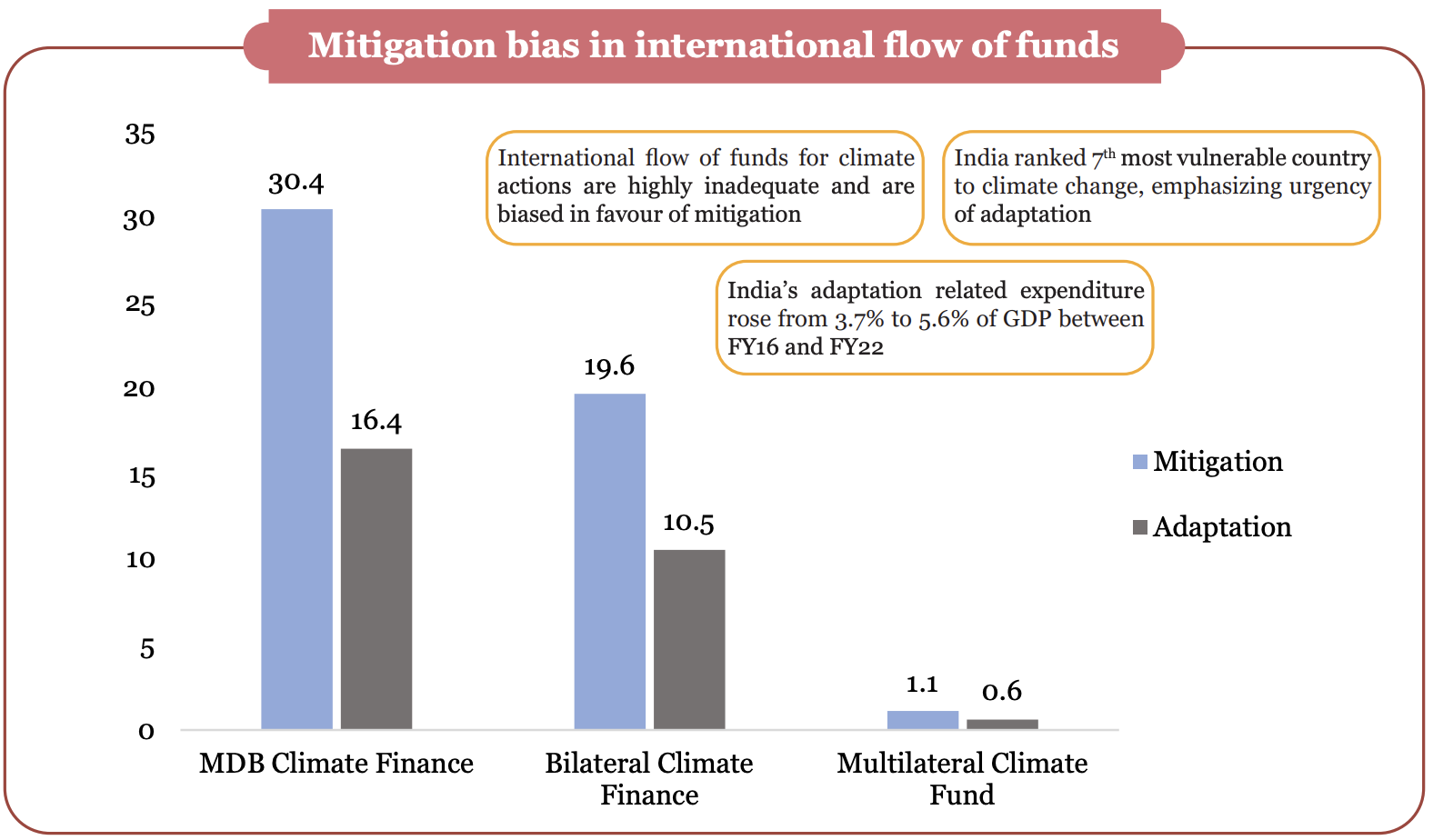Introduction
- India's per capita carbon emissions are 1/3rd of global average, even as it stands among the world's fastest-growing economies.
- As per the Forest Survey of India 2024 an additional carbon sink of 2.29 billion tonnes CO2 equivalent has been created between 2005 and 2021.

Bringing adaptation to the forefront
- India is the 7th most vulnerable country to climate change.
- India's adaptation spending rose from 3.7% of GDP in FY16 to 5.6% in FY22, funded largely by domestic resources with the public sector leading.
- However, international climate funding remains insufficient and focused more on mitigation than adaptation.
- The Ministry of Environment, Forest and Climate Change (MoEFCC) is developing the National Adaptation Plan (NAP), a key document outlining India's adaptation priorities.

Initiatives taken to build resilience in various sectors
- Adaptation in agriculture: It includes increased focus on research and development of climate-resilient seeds, measures to preserve and enhance groundwater resources, improve soil health, and modify cropping practices.
- Building resilience in urban areas: As urbanization and climate change increase, there's growing focus on adapting to heat stress, urban flooding, and shrinking groundwater in cities.
- Key Interventions: The National Mission on Sustainable Habitat (NMSH), AMRUT, Smart City Mission, Urban River Management Plan, River Cities Alliance (RCA).
- Adaptation in coastal regions: India's long coastline faces extreme climate events such as heavy rain, severe storms, high tide flooding, etc.
- Key Interventions: The 'Mangrove Initiative for Shoreline Habitats & Tangible Incomes (MISHTI), Conservation and Management of Mangroves and Coral Reefs' scheme, Coastal Regulation Zones
- Adaptation action for water management: Jal Shakti Abhiyan, National Aquifer Mapping Project (NAQUIM), Bhu-Neer portal, The Flood Watch India app.
Energy transition - learning from the experience of developed countries and weighing the options
- Coal: Unlike many developed countries, India relies heavily on coal, holding about 10% of global reserves but just 0.7% of natural gas reserves.
- India has installed electricity generation capacity of 2,13,701 megawatts from non-fossil fuel sources, which accounts for 46.8% of the total capacity.
- New initiatives and updates on existing policies/schemes to boost energy transition: New Solar Power Scheme (for Tribal and PVTG Habitations/Villages) under PM JANMAN and Dharti Aabha Janjatiya Gram Utkarsh Abhiyan (DA JGUA), PM - Surya Ghar Muft Bijli Yojana, Viability Gap Funding (VGF) scheme for offshore wind energy projects, Green Energy Corridor (GEC), The National Bioenergy Programme, PMKUSUM, National Green Hydrogen Mission.
- Lesson Learnt: Lessons from developed economies warn against shutting down thermal energy without reliable technological alternatives for stable energy supply.
- Developments in financial regulation on green investments: SEBI introduced new reporting mandates on ESG parameters - Business Responsibility and Sustainability Report (BRSR), issuance of green debt securities, Sovereign Green Bonds (SGrBs) etc.
Optimising lifestyles for sustainable development
- India launched Lifestyle for Environment (LiFE) Mission at COP26 in 2021 to promote eco-friendly, nature-aligned lifestyles.
- According to estimates, almost 17% of all food available to consumers worldwide is wasted annually, amounting to > 8% of global greenhouse gas emissions
- By 2030, LiFE measures could save consumers globally about USD 440 billion through reduced consumption and lower prices.
- Key Interventions: PM KUSUM, PM Surya Ghar: Muft Bijli Yojana, Ecomark scheme, Go Electric' campaign, Perform Achieve and Trade (PAT) scheme, Ek Ped Maa Ke Naam,Green Credit Programme.
Circular Economy and Resource Efficiency
- Resource circularity could save 11% of GDP by 2030 and 30% by 2050.
- Key Interventions: tax benefits, subsidies, and low interest loans to the recycling industry, extended producer responsibility (EPR) framework.
- Plastic Pollution: By 2050, plastic will account for 15% of global greenhouse gas emissions. India has one of the lowest per capita plastic consumption rates, at 14 kg, compared to global average of 35 kg.
- Air pollution: WHO data shows 99% of the global population breathes air with pollutant levels above safe limits, with low- and middle-income countries facing the highest exposure..
- Key Interventions: National Clean Air Programme (NCAP), Graded Response Action Plan, 'Promotion of Agricultural Mechanization for In-Situ Management of Crop Residue in the States of Punjab, Haryana, Uttar Pradesh & NCT of Delhi.
Conclusion
India aims for net-zero emissions by 2070, aligning this goal with its ambition to become a developed nation by 2047. Achieving this vision requires balancing low-carbon development with energy security, job creation, economic growth, and environmental sustainability.
One-Line Summary:India's climate policy focuses on adaptation and energy security, balancing economic growth with sustainability and resilience against extreme weather events. |
Relevance for UPSC:
|


